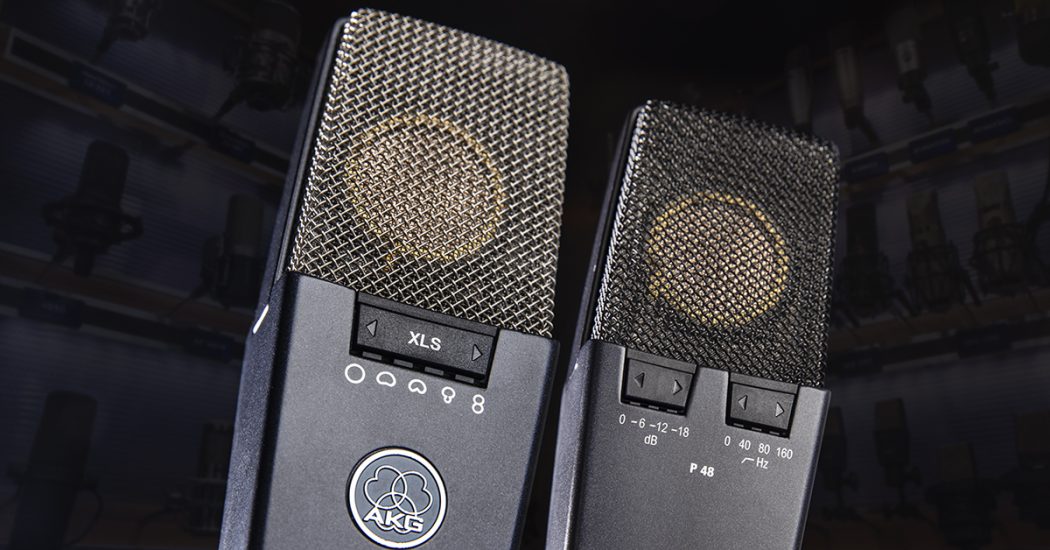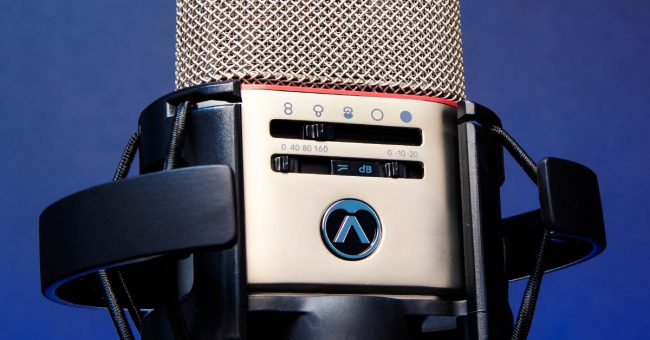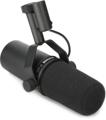
Whether you’re a DAW-based solo artist or aspire to record bands for a living, there comes a time when you’ll be staring at an empty microphone cabinet or road case and considering how best to populate it. It’s a daunting task, during which you will be confronted with a mountain of features, terminology, and technical specifications that can be confusing for the uninitiated. If you are in this situation, fear not: Sweetwater is here to cut through the hype, to demystify the jargon, to explode some myths, and to give you a better understanding of what matters (and what doesn’t) when it comes to choosing microphones.
Mic Basics: Dynamic, Condenser, and Ribbon
Any competent mic locker will include dynamic, condenser, and ribbon mics. Why? Because each type is more or less suited to any specific situation you will encounter, either onstage or in the studio. Within (or hybridizing) the basic categories, you’ll also find specialized, purpose-built microphones optimized for specific sound-capture duties.
Dynamic Mics
Rugged and able to withstand high SPLs (sound pressure levels), dynamic microphones are go-to workhorse mics for capturing loud sources like electric-guitar cabinets and drums. Durable and resistant to handling noise, dynamics are also popular for live vocals; although we should note that today’s handheld condenser mics are arguably just as hardy and, for the most part, offer higher fidelity and are more adept at capturing the subtleties of a performance.
Condenser Mics
Condenser mics are your choice for high-fidelity capture of nuanced sources. Traditionally, condensers come in two form factors: small diaphragm and large diaphragm; although, in the past decade, we’ve seen more medium-diaphragm condenser mics enter the marketplace. Generally speaking, small-diaphragm “pencil” condenser mics tend to be preferred for sources with fast transients, like acoustic guitar, while large-diaphragm mics are, more often than not, used for vocals. That being said, in the words of the immortal Captain Barbossa, these are more of what you call guidelines than actual rules.
Ribbon Mics
Ribbon mics (which are technically a subset of dynamic mics) have made a comeback in the new millennium. Before the first condenser mics made their way stateside after WWII, ribbons were the only choice for professional applications such as music recording, radio broadcast, and motion pictures. But, in addition to being heavy and cumbersome, vintage ribbon mics were also notoriously delicate and could be damaged by a stiff breeze, much less high SPLs or strong blasts of air. Today’s ribbons are a different breed. They still deliver the velvety response that makes them desirable on harsh-sounding sources, but most are also robust enough to be used on boisterous electric-guitar amps and drums.
Specialized Mics
Within the realm of specialized microphones, “kick drum mics” feature a frequency contour with low-end and upper-midrange presence boosts that makes them ideal for beefy sources such as bass drums, floor toms, and bass cabs. Engineered for surface mounting, boundary mics are an ideal solution when you don’t have room for conventional mics, such as when capturing a grand piano with the lid closed. Stereo mics are designed to capture sources in (you guessed it) stereo and commonly offer soundstage width and other adjustments. Long shotgun condensers, usually mounted on boom poles, are made for capturing natural-sounding dialog at a distance on a set, while short shotguns are typically designed for mounting on video cameras. Wireless microphones have come a long way in the last two decades and are available today in a wide variety of formats to suit any live sound (or even studio) application. These are just a few examples, but you get the idea: today’s microphone market leaves no stone unturned in the interest of addressing the widest range of recording and sound reinforcement scenarios.
SPL (Sound Pressure Level)
This is an important specification. Say you’re recording a lead vocal. The performance is absolute magic right from the get-go. The singer nails the first verse, gets to the chorus, and powerfully hits that high note — and the mic distorts. Don’t let this happen! A reasonable grasp of audio engineering theory, combined with a microphone’s maximum SPL rating, can spell the difference between a Grammy-worthy recording and a disaster. To that end, many condenser mics are equipped with a pre-attenuation pad that reduces gain before the first stage of the input amplifier by 10dB or more to protect the capsule from overload. So, by all means, pay attention to this spec. Know what it means. And use the supplied pad when warranted!
Polar Patterns
A mic’s polar pattern determines from which direction(s) it picks up sound, and it’s another important spec you’ll encounter when considering any microphone, regardless of type. Here are the polar patterns you should know.
Cardioid
Cardioid is the most common (and useful) polar pattern because it mainly picks up sound that’s in front of the microphone. Cardioid mics offer reasonable side and rear rejection, so you’re not capturing lots of unwanted ambient sound along with your intended source.
Figure-8
Figure-8 (the native polar pattern of ribbon mics) is like having two cardioids back-to-back, picking up sound equally from both directions. Figure-8 mics typically offer even better side rejection than cardioids, making them surprisingly useful in live situations such as miking an amp backline.
Omnidirectional
Omnidirectional mics capture sound, well, from pretty much everywhere. Spaced omni mics are effective at capturing the ambience of a room or a live acoustical event such as a symphony orchestra performance.
Multi-pattern Mics
Multi-pattern condenser mics frequently offer a choice of three switchable polar patterns — cardioid, omnidirectional, and figure-8 — which gives you immense flexibility when it comes to exploring the sonic possibilities offered by different recording techniques. To complicate matters further, some mics also offer variations of each pattern, such as hypercardioid (which is more highly directional than cardioid but exhibits a rear “lobe” that can make mic placement challenging) or wide cardioid. Consider the classic AKG C12 and its modern variants, which offer a whopping nine polar patterns! Having access to multiple polar patterns not only increases your flexibility in dealing with mono sources; but it also exponentially opens up a menu of stereo mic techniques such as spaced pair (A/B), XY (including Blumlein), ORTF array, and mid-side (M-S).
Shotgun or Lobar
A shotgun mic is one that offers a very narrow lobar pickup pattern with great rejection from the sides. These are useful when you need to record a sound and separate it from a loud or reverberant setting, such as actor voice pickup on a motion picture set. They also work very well for interview settings (boomed in from above) when you don’t want to see any mics on camera.
Here’s an article that allows you to hear the sounds of different polar patterns.
You’ve likely seen microphone polar pattern diagrams, but do you really know how different they sound when comparing on- and off-axis? Take a listen.
Gold-Sputtered Capsule Diaphragms
You’ve likely heard of gold-sputtered capsule diaphragms. Many microphone manufacturers flout them as if they are an exotic feature. But the reality is that virtually all modern condenser mics have gold-sputtered capsule diaphragms. For scientific reasons, it is common practice to make them that way. You often see audio equipment with gold-plated connectors; and that is because gold is a highly effective electrical conductor, which also makes it perfect for coating diaphragms. However, condenser-mic diaphragms need to be ultra-low mass, so plating them with a relatively thick layer of gold is out of the question. But sputtering, a technique for applying a molecular layer of atoms to a surface, is an effective way to make a capsule diaphragm both highly conductive and supersensitive.
Frequency Response
Many pro audio manufacturers often quote a frequency range for a particular product (not just microphones) without including a reference level (e.g., +/- 3dB, a fairly common reference). Without that reference, a manufacturer could claim a condenser microphone (or any other piece of gear) has a range of 20Hz to 22kHz; which might be technically true, but the response might actually be down 15dB at 20Hz and 20kHz. As a consumer, you might think that the mic was high fidelity, with excellent bass and treble extension, when its actual performance is rather feeble. Even better than quoting a reference level is publishing a frequency-curve graph, which gives you a complete picture of the frequency response, complete with any dips or bumps. A good example of this is a condenser mic like the classic Neumann U 47 with a built-in presence boost in the upper midrange. A mic like this is great for certain vocalists, but it certainly wouldn’t be our first choice for a singer with a naturally strident voice. Good to know.
Bass Roll-off (Highpass Filter)
Relevant to frequency response is the bass roll-off feature found on many condenser microphones and even on some dynamic mics. Sure, you could attenuate bass frequencies with an equalizer post-preamp, but hitting your mic preamplifier with frequencies you know you don’t want will reduce your headroom — so why do it when you can roll off the offending bass frequencies at the source? A bass roll-off is also useful for getting rid of structure-borne rumble; although, ideally, this should be mitigated by using a proper shockmount. Having a highpass-filter circuit onboard the mic can be very handy, indeed, which is why so many manufacturers include it on their microphones.
In Conclusion
There you have it. Hopefully, we have removed much of the mystery of mic shopping, so you can go forth in your quest with confidence. Next steps? Check out our exhaustive offerings from the finest professional microphone manufacturers in the business. As always, should you have any questions or need expert, personalized guidance, reach out to your Sweetwater Sales Engineer at (800) 222-4700. You’ll soon be on your way to the mic locker of your dreams!






